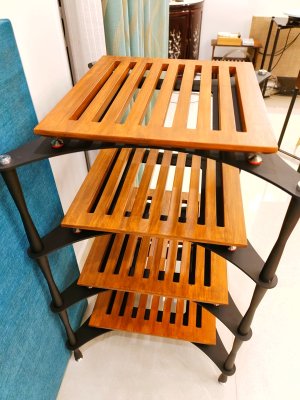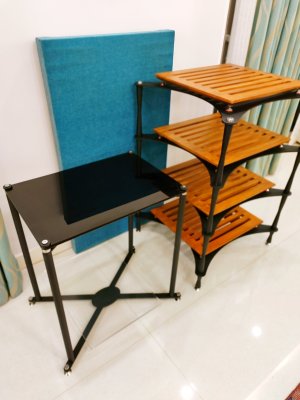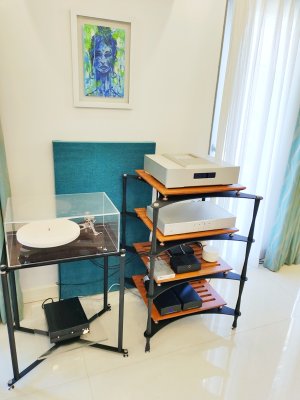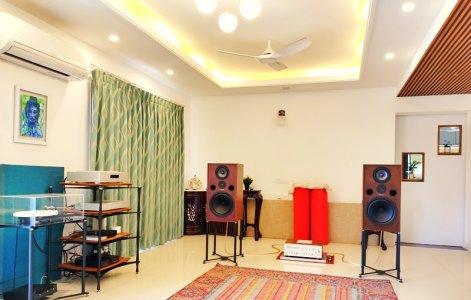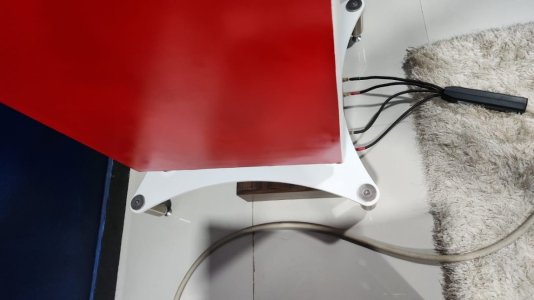Just got most of my amps back from regular service. And wanted extra racks to house the whole setup. So reached out to sound foundations again. My original amp stands are custom from sound foundations and were built in 2018. I wanted exact same new ones, so I could stack one above the other. But I didnt have their design or dimension details from the past. I could measure with a tape, but when we are talking about millimeter precision, that wont work either. Since I wanted exact replica's I offered to courier back one of my amp stands. But luckily Mr.Ali ( aka
@magma ) had the records of my previous build. ( Apparently he has records of everything

). So we got 3 more exact stands built.
And while we were at it, I also went with a few pairs of Cerabase ( Isobase ) isolators to add further isolation in the stack.
Got my stands delivered yesterday. And rigged everything up today. Holy cow... they are beautifully machined and built. The fit and finish is nothing short of stunning.
Below is how the top amp rack's spike fits exactly into the cup of the lower rack. That's called precision in my books

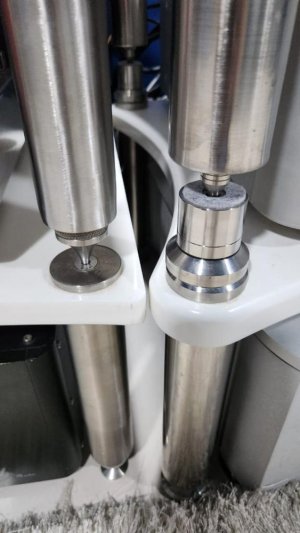
Below is how i added Cerabases to add height and further isolation between different levels of the stack. The idea is to isolate the CD player and the turn table from the rest of the gear when one of them is playing.
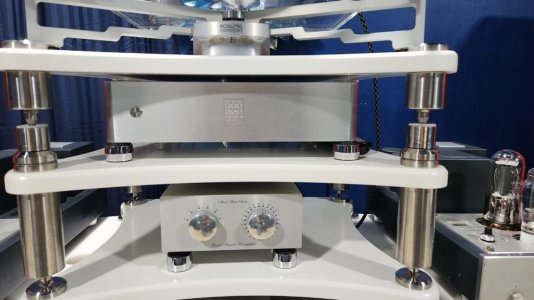
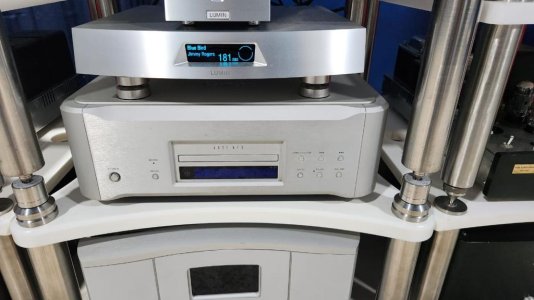
So this is what the whole rig looks like. Everything white that you see in the pic is from sound foundations. And that includes the massive speaker plinths, central epsilion rack ( this houses only the source components ), and the twin side amp stands that hold my 3 pairs of mono blocks. And every rack or stand grounds into the one below through a cup and spike arrangement due to immaculately precise machining. All in all, Iam extremely delighted with them. I really dont know if it has improved the sound, my hearing is all but mostly shot, I struggle to hear differences between dacs or cables. So even if there is an improvement, it is beyond my hearing ability. So i will not tread into that subject. But what they do, is house my whole kit beautifully and aesthetically, while still isolating each component from the other.
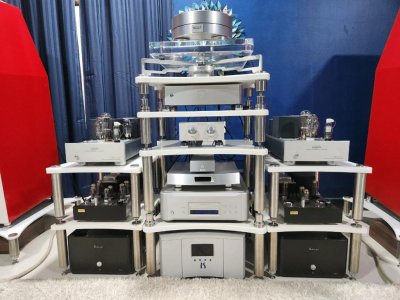
And below is a pic of my speakers on sound foundations speaker plinths, I have external passive crossover boxes for my DIY speakers built by
@Hari Iyer . And the room is small. So i went with the plinths to reduce bass transmission into the floor and into my lower apartment. And at the same time, house the crossover boxes underneath. My lower neighbour has never complained about my immense listening levels ever since. So the plinths do work, and the bass doesnt travel to the floor below. The crossovers are usually off the floor and on townshend seismic platforms, but they are currently with a friend. ( And yessss...isolating the crossovers from floor borne vibrations makes a noticable diference ). All in all, a few of the items you see are custom for my requirements. But most of the rest is readily available on their sound foundations site. I guess Iam almost sounding like a advert, but I would like to call myself a convert. And one who is immensely pleased with the end result. And I should add, that we are now in talks to build a custom TT stand for me. So I can move the TT rig upto the phonostage to the side of the room. As it currently is annoyingly at head height.
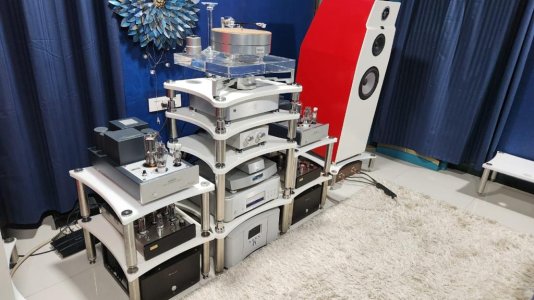
I thought I will add further about the speaker plinths.
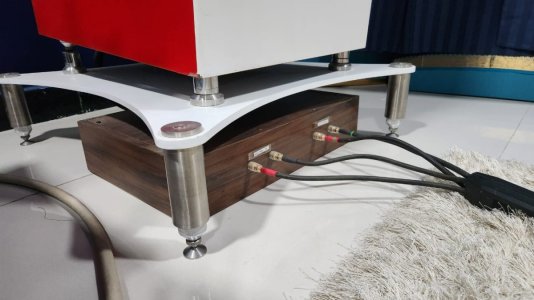
The design and implementation is different from the norm, but it works beautifully. Each speaker is almost 100 kgs, so the usual isoacoustics or townshend isolators will cost a bomb to work their magic on these speakers. So we got these plinths custom built to drain the residual vibrations into their housing shoes at the bottom. And the speakers themselves dont sit on plinths as is usually the norm. The speakers sit on cera bases. And the cerabases isolate as much as they can. And the residual vibration is transmitted to the steel plinth. Which then drains the vibration through its stainless steel legs, which are again filled with vibration absorbing attabites. So whatever is left, goes into the cups on the floor holding the spikes.
Below is a pic to show the shape and design of the speaker plinth.
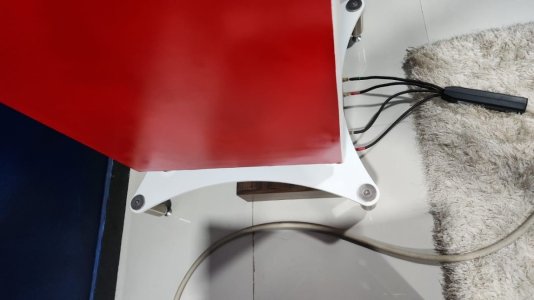
Vibrations travel along lines of low pressure. Hence the shape is designed to move the vibrations to the corner of the plinth, where the legs with inbuilt attabites absorbs the residual vibration from the cerabases. And what is left is drained to the cups on the floor. And ive experimented with the placement of cera bases and spikes under the speakers. And finally settled with no spikes in front. So the rear of the speakers have a spike ( Again from sound foundations ) going into a cerabase. And the front doesnt have a spike, and just rests on a cerabase. The end result is excellent bass clarity, and an uptick in imaging without annoying my neighbours.. I guess I will stop now, or it will look like a paid endorsement

.
And did I mention that the pricing is very very reasonable for what you get in the end

. Some of my stuff is custom, so is slightly more expensive than the readily available kit on the site. But everytime you go custom, there will be obvious new challenges in design and implementation. And with
@magma being very particular about what he delivers......it will take up his precious time to research the design and come up with a build. So, all in all, Iam extremely happy with my stuff from sound foundations, over the last 5 years. And Iam confident enough to proceed with my next TT stand build with them. Will post pics once I have it in the house. And thanks for reading


